In boating circles, the word friendship brings to mind the classic Maine-built sloop from which pre-internal-combustion lobstermen tended their traps. For Richard Armstrong, however, the word conjures up a different image—a small catboat designed for the burgeoning summer community of Friendship, Maine, in the beginning of the 20th century.
In 1925 Friendship summer resident, artist, and sailor Bill Kirkpatrick (“Billy Kirk” to his friends) set about designing a small boat that would satisfy the needs of his community. He wanted a simple, inexpensive craft that could serve as a sail trainer and family daysailer, but also provide spirited performance around the buoys. The Friendship Catboat was the result.
Early last fall, Richard Armstrong asked Buzzards Bay Yacht Services, the shop I work for, to build a pair of Friendship Cats. The plans arrived in my inbox shortly thereafter in the form of a single JPEG file that printed out to a scale of ½″ to the foot, along with a handwritten table of offsets. A quick trip to Staples resulted in a more workable copy, representing 1″ to the foot.
The lines showed a simple, two-chined hull with a flat bottom and measuring 16′1″ overall. The hull draws a little more than 4″ with the board up, and a beam of 5’8″, which is narrow in comparison to a Cape Cod catboat of that size. The boats also differ from a Cape-style cat in the pronounced rake of stem and transom. The plan shows a traditional gaff rig, somewhat high-peaked, with a boom that overhangs the transom slightly. The sail area is roughly 130 sq ft—more than ample to deal with the often light breezes of Maine and provide spirited performance when the wind pipes up. My first impression was of a handsome little boat that, while being easy to build, was also pleasing to the eye.
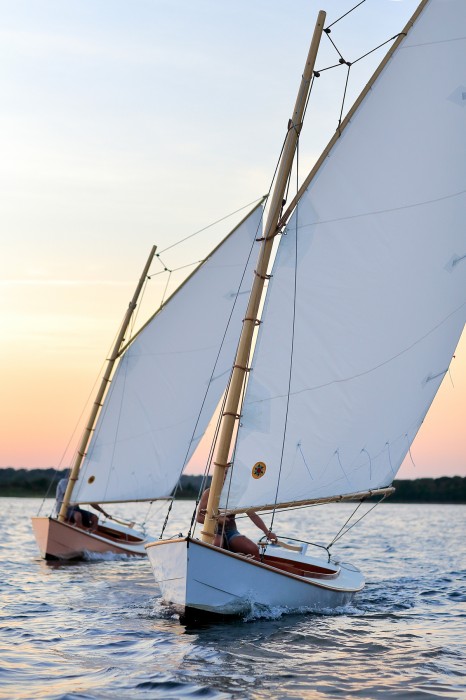 this and opening photo by John Robson
this and opening photo by John RobsonBuzzards Bay Yacht Services of Rochester, Massachusetts, launched two new Friendship Catboats last summer for longtime Friendship summer resident Richard Armstrong, who gave the boats to his daughters.
The summer residents around Friendship evidently agreed, and eight boats were built over the next few years for $100 each. Archie Thompson and Gene Brown of the Friendship Boatshop were in charge of the construction. The boats were a hit; families used them to explore the area’s rocky coastline, a competitive racing series was quickly developed, and many a boy and girl learned the fundamentals of sailing in the cockpit of the Friendship Cat.
One of those boys was Richard Armstrong, who first took the helm at the tender age of nine. Richard’s family had been involved with the boats since the beginning. His grandparents received one of the original five Friendship Cats, as did his great-aunt and -uncle. Some of the boats were passed through generations, while additional boats were acquired by his extended family over the years.
A resurgence of interest in the class began in 1979 with a boat built by the Apprenticeshop, which was then in Rockland, Maine. Six more were built in 1983 and 1984 by Doug and Paul Lash of the Lash Brothers Boat Yard in Friendship. One of these boats, HARLEQUIN, was built for Richard, and was on hand in our shop during construction of the new boats. Another, ANDIAMO, was built for Richard’s sister, Amy.
In all, 17 Friendship Cats have been built over the years, and most are still sailing today. Seven of those have ties to the Armstrong family. The older boats are mostly original, although all that are still sailing have been updated with ’glassed-over plywood bottoms, a modification that Richard himself introduced.
 Jeremey Burnard
Jeremey BurnardRichard Armstrong tows a line of Friendship cats home from the racecourse.
The original boats were built upside down, with heavy 3/4″ pine planking sprung over molds to meet the equally heavy oak stem and transom. The topside planks were riveted to the upper and lower chines every 4″, while the bottom was cross-planked with 1″ pine over a robust 8″ x 1 ¼″ oak keelson and fastened with ring nails to the 1″ x 3″ oak chine logs. The transverse oak framing was somewhat minimal, with three sawn pairs located at high-load areas. The trunk sides were also 1″ oak, screw-fastened without benefit of logs from below; the trunk housed a heavy oak centerboard. The trunk’s forward post tied into the aftermost full deckbeam, while its aft end is braced by a thwart that captures the after trunk post. Decking was 5/8″ pine over heavy oak beams.
By now you may have noticed that the word “heavy” is showing up a lot in this description. I believe this was as much a result of readily available lumberyard stock as it was the Friendship Boatshop’s familiarity with building workboats. Richard wanted his two new boats to be lighter and stiffer than the originals, and so chose plywood for the topsides and bottom.
We lofted the stations full size and built the pine molds directly on this lofting; we then stood the molds upside down on a strongback, notching them to receive the keelson and chine logs. A 2″-sided oak stem, faithful to the original, was added, as well as a ¾″ plywood transom, framed with ¾″ fir. To these, the ¾″ fir keelson and chines were bent, glued with epoxy, and fastened before planking. Plank patterns were taken off the mold using strips of 1/4″ plywood doorskin glued together with hot glue. These shapes were traced directly onto 3/8″ marine plywood that had been previously scarfed to length. Rather than stitching with wire to be removed later, the planks were epoxy-glued and permanently fastened with stainless-steel screws at chine, knuckle, stem, and transom. The plywood bottom was fastened to the keelson and chines using the same method, then sheathed in two layers of bidirectional fiberglass cloth set in epoxy.
At this point, the hulls were removed and braced to the correct shape while the decks were framed with ¾” fir, which in turn was stiffened by a series of plywood knee-like frames. The centerboard trunks were built of ½″ plywood over posts and logs of oak, and fastened using the same technique, before being through-bolted into place. The centerboards were cut from ½″ G-10 fiberglass sheet, while the rudders are ½″ plywood wrapped in ’glass, with copper-riveted oak cheeks.
The decks are 1/4″ plywood covered with Dynel set in epoxy, which added a little stiffness, along with providing a durable nonskid surface.The entire boat was sealed with epoxy before painting. Mahogany coamings were added, and the rubrails, cleats, and tiller are all of black locust. The boats are often sailed from the cockpit sole, like a Beetle Cat, so teak grating was fitted to keep the captain and crew’s bottoms dry. The spars are of solid spruce.
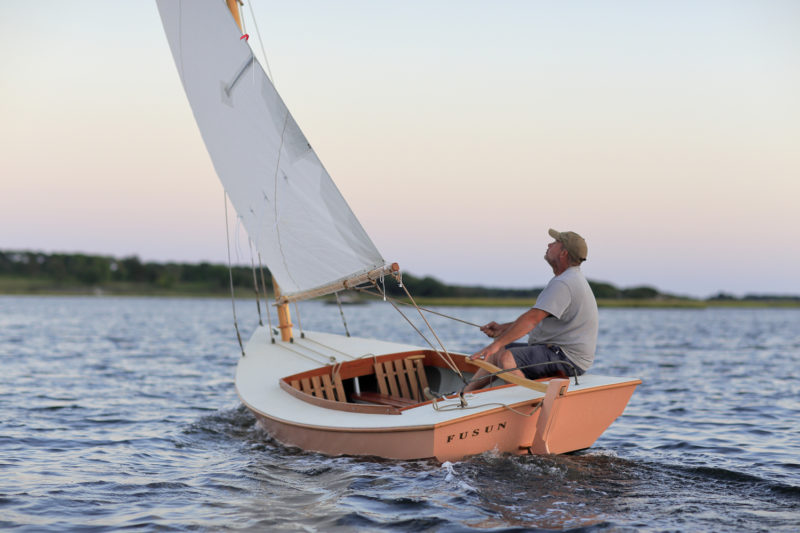 John Robson
John RobsonAuthor Christian Smith revels in the simple joy of sailing a Friendship Cat.
The result is a stiff and rugged boat able to withstand years of use with a minimum of upkeep, while being lighter than the originals. The cockpit is capacious, and the volume sufficient to carry a family of four and a dog, if the pooch behaves itself. The teak grates make for comfortable, dry lounging, while the addition of two removable seat backs that brace against the forward coaming offer an extra level of comfort for passengers.
The flat bottom, long shallow rudder, and free hanging centerboard make for a great boat to explore the rocky marshes of the Westport River in Massachusetts, where Richard now lives. When faced with a calm, a captain of one of the original boats could row the Friendship Cat seated on the thwart aft of the trunk. On the new boats, this thwart was replaced with a wineglass-shaped knee at the aft end of the trunk, in favor of more room in the cockpit. A pair of long paddles live under the foredeck, and it is where they will stay if anything close to a breath of wind presents itself, as these new boats have shown themselves to be quite the light-air performers. The afterdeck supplies a wonderful space for the helmsman to sit—although, while sailing solo, I often found myself hiking my cheeks over the coaming onto the side deck in even modest puffs to keep the boat flat, where she sails best.
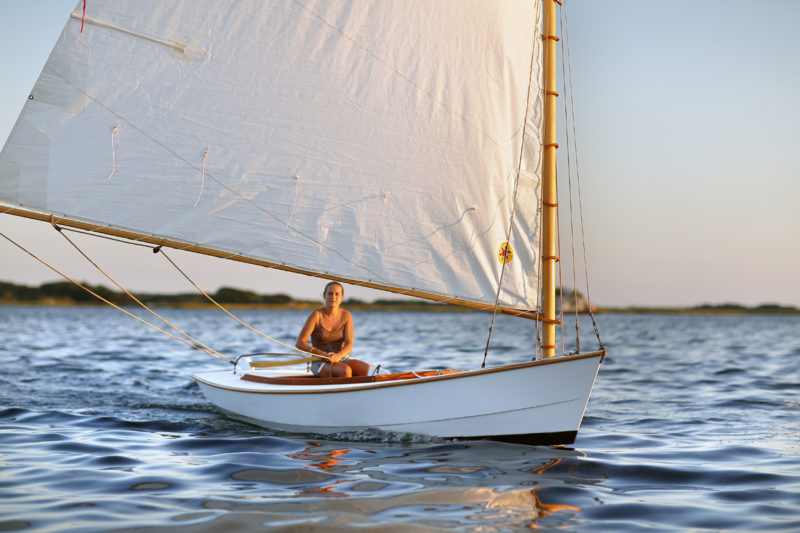 John Robson
John RobsonAnnabelle Armstrong skippers the catboat her father had built for her.
Let the boat heel, and the generous flare amidships helps keep everything right-side up. I did manage to dip the rail once or twice upwind, but everything remained smooth and fluid, with no sudden panic-inducing lurches; a subtle ease of the sheet or feather of the rudder brings everything back to rights. The boats exhibit excellent upwind performance for a cat, and easing the sheets only adds to the excitement, as even the heavier originals are known to get up on a plane when sailing off the wind.
This boat combines good looks, simplicity, and exciting performance. Still, every boat has its limits, and on an evening sail last summer I had to remind myself that this cat was designed for Maine’s light breezes and island-protected coast. I’d consider adding a second reef before calling it a sail trainer. It’s not a boat in which to conquer the heavy wind and steep chop of Buzzards Bay. Even a stiff breeze in the harbor will have the captain wanting a reef, or crew, or both. But, as the name “Friendship” suggests, this is a boat that invites company to enjoy in the fun. Whether on a Saturday family excursion to the beach down harbor, an evening cocktail cruise through the marshes with a sweetheart, or a wet windy afternoon around the buoys, the Friendship Cat will supply no shortage of fun and simple joy.![]()
Christian Smith is a third-generation boatbuilder, and a circumnavigator, chainsaw artist, and general Renaissance man who classifies himself a “new old school Yankee.” He founded the New Bedford, Massachusetts-based youth boatbuilding program Greenfleet, and he cures his own bacon.
Friendship Catboat Particulars
[table]
Length/16’1″
Length on waterline/13’9″
Beam/5’10”
Draft/6″ (board up)
/2’4″ (board down)
Sail area/122 sq ft
[/table]
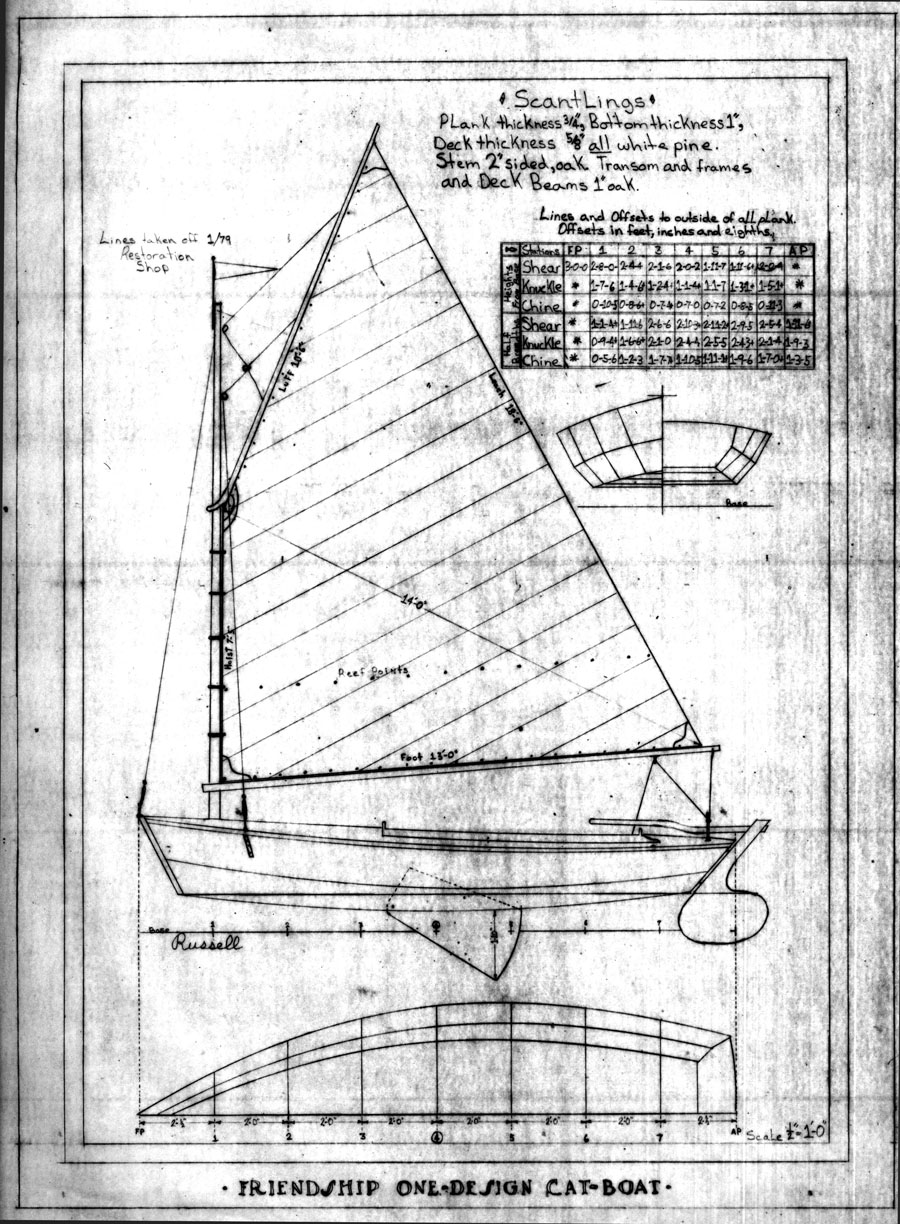
The Friendship cat, as measured by the Maine Maritime Museum in 1979.
Plans for the Friendship Catboat are available from the Maine Maritime Museum of Bath, Maine.
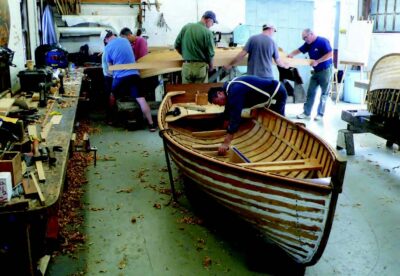
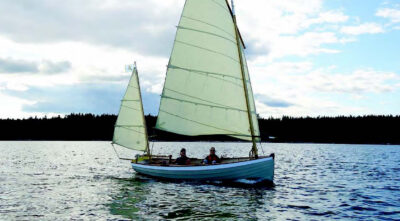

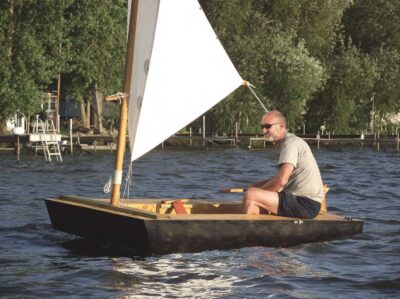
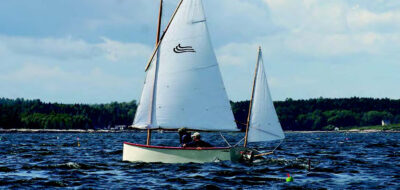
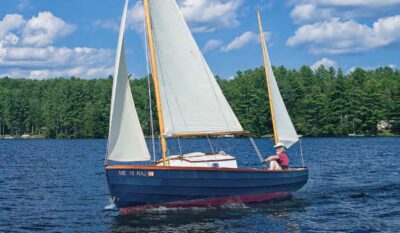
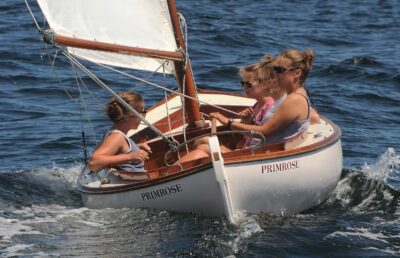
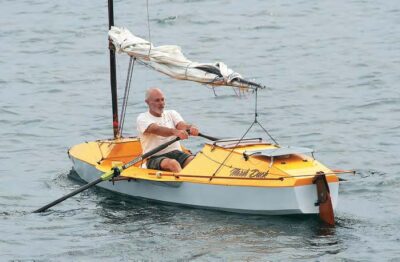
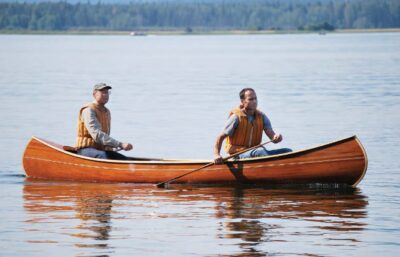
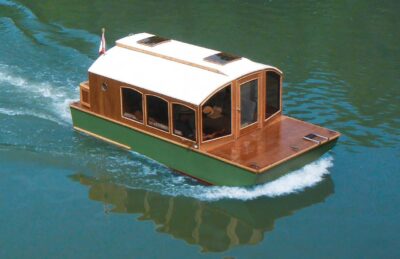


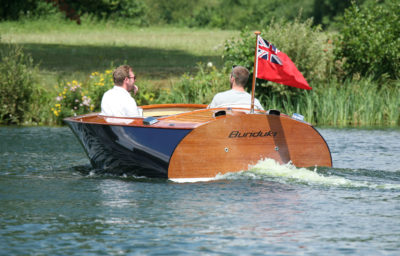
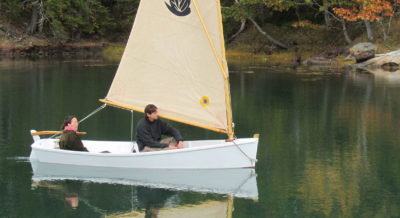
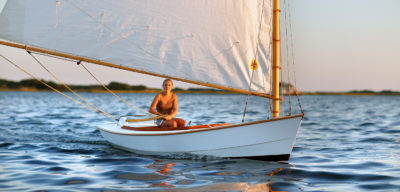
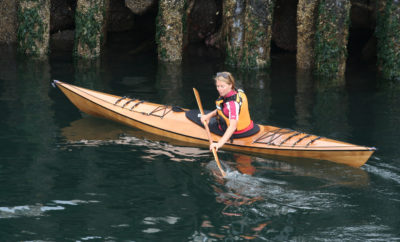
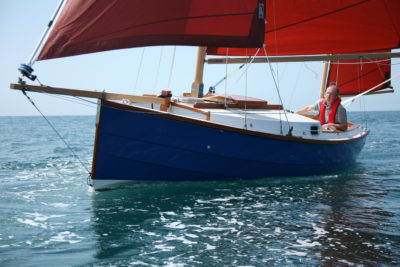
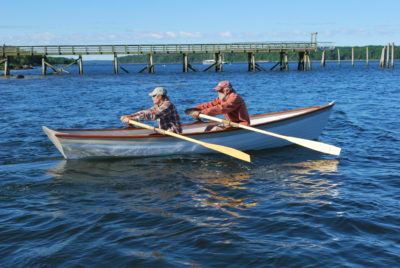
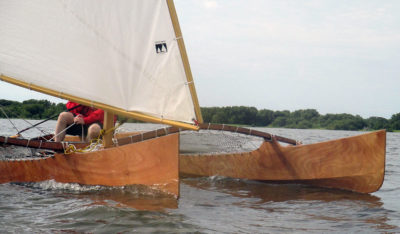
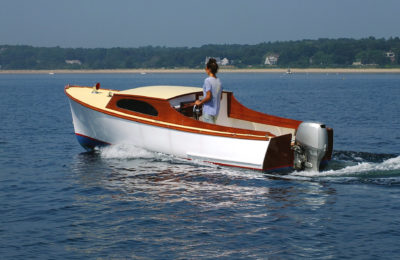
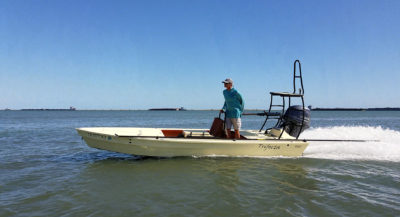
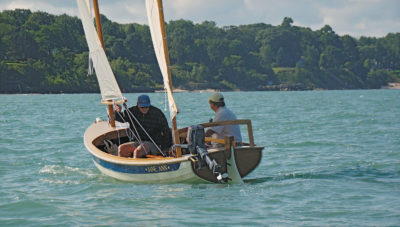
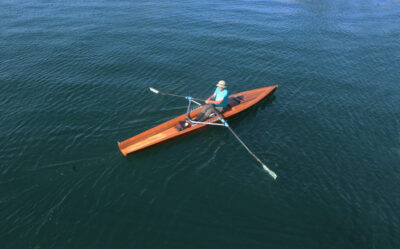
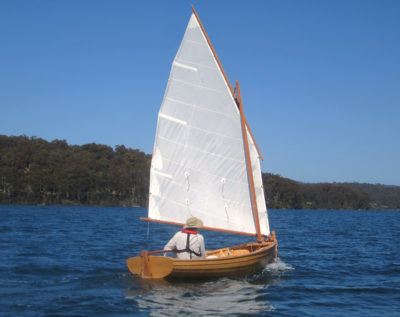
Reminds me of the Cotuit Skiff, an old design of a cat rigged sharpie probably still being raced in Cotuit on Cape Cod. They were known to be fast, overcanvasssed boats that were a handful when the conditions got breezy. Looks like the leading edge of the rudder might be a weed catcher.
Looks like a great trailer-able boat. I live near Marion, MA “Buzzards Bay” for the non-locals and the second set of reef points would definitely be one of the changes I’d make. I am looking for another boat to build and add to my fleet as I get closer to early retirement. I am now considering the Friendship catboat, Peapod and Marisol skiff. -J. Taylor
This was a terrific article and I appreciated the detailed information on the building process. It brought a smile to my face to read that the first boats cost $100 a piece! Thank you for another enjoyable issue.